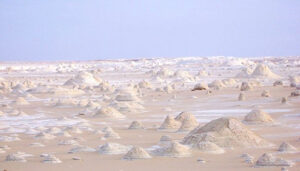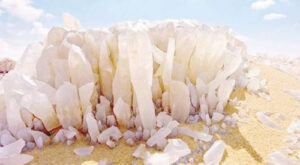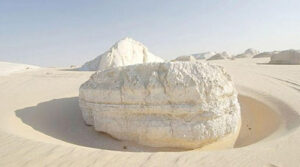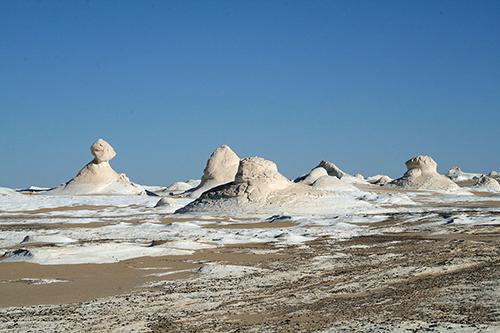Compiled by Amr Emam
Located around 45 kilometres north of Farafra Oasis, the White Desert is a great attraction in Egypt’s Western Desert.
The desert is part of the New Valley governorate. It is around 500 kilometres away from Egyptian capital Cairo.
The White Desert was declared a nature reserve in 2002.
It acquired its name from the white colour that covers most of it. The desert extends over 3,010 square kilometres. It has a huge chalk rock.

The White Desert contains many formations that were created as a result of accidental sandstorms in the area over the centuries.
Farafra Oasis and the White Desert are typical places for tourists who like nature and camping. They are also ideal for researchers and students.
The desert has turned into what is considered an open-air museum for studying the desert environment; geography; fossils, and Egypt’s fascinating wildlife.
It was unanimously chosen by experts to be the first Egyptian geopark that meets the criteria set by UNESCO.
The White Desert has one of the most beautiful landscapes in Egypt and the world. It is completely different from any other place on this planet.
When the night falls in the desert, Bedouins usually prepare traditional dinners for visitors.

The smell of food often attracts desert foxes which sometimes rely on visitors’ leftovers for food.
The region is characterised by its beauty at night, especially when its stars illuminate the sky, making it one of the best locations to observe the beauty of the sly.
The area also embraces bizarre rock formations, including ones mimicking chicken and others in the shape of mushrooms.
Fossils scattered across the White Desert are a clear indicator of climate change in that region throughout history.
Some of the rocks date back to the Cretaceous Period, around 70 million years ago. These rocks were formed as a result of the immersion of the Tethys Ocean which is named after the sea goddess in Greek mythology.
There are many rocks that are famous for their names according to their sculptural shape, the most famous of which are the Camel Rock, the Horse, and the Falcon.
There is another rock that is moulded on the shape of the African continent.
In ancient times, the White Desert was full of people. The inscriptions and decorations that adorn the walls of the White cave, a desert landmark, present proof of the civilisation that prevailed in this area 10 thousand years ago.
Those inscriptions are animal motifs that reflect the traditions of Nubian rock art.
There are drawings of two human hands decorated with the walls of the cave.

The reserve is also famous for the Crystal Mountain, a mountain consisting of rocks with over 125 different types of crystal brought together by nature in a huge mountain massif.
This mountain is believed to have been formed when a huge meteorite hit the Earth millions of years ago in that area.
The meteorite is believed to have caused the rock of the mountain to melt, turning into rare and unique pieces of precious crystal, one of the purest and most expensive in the world.






Discussion about this post